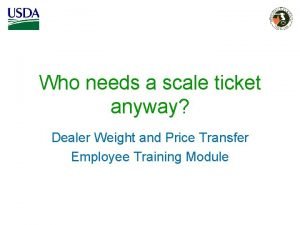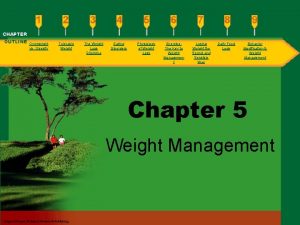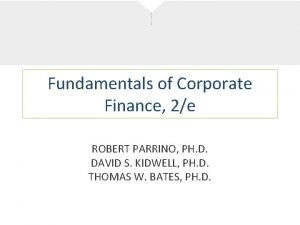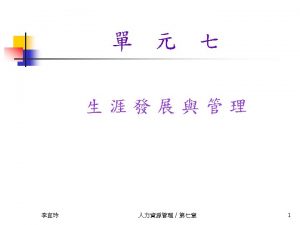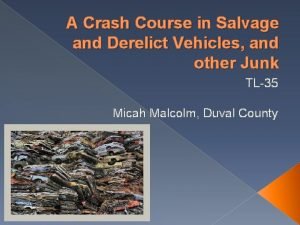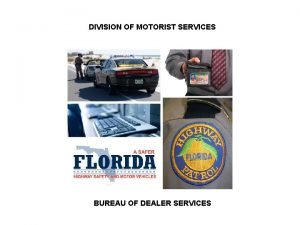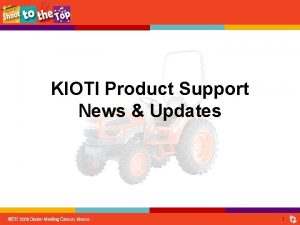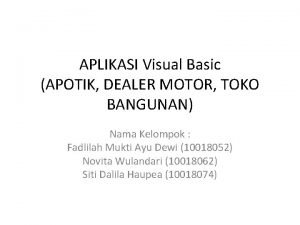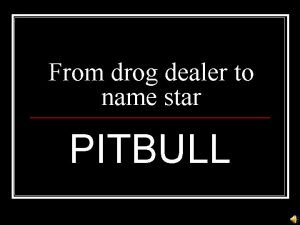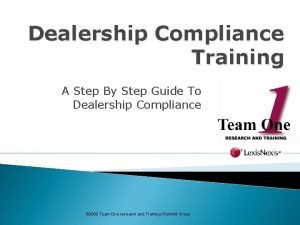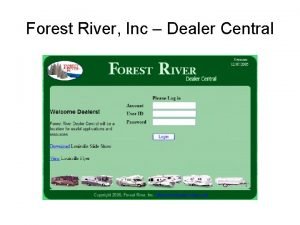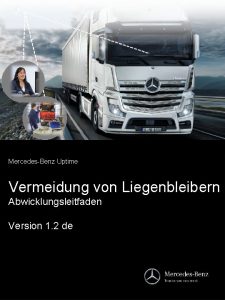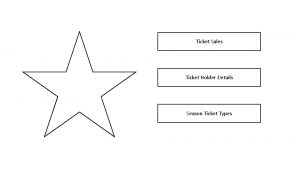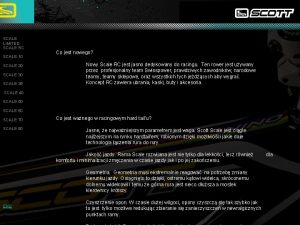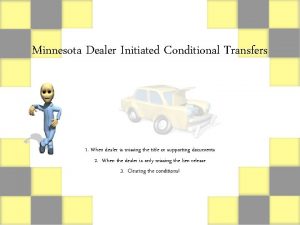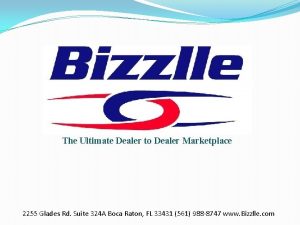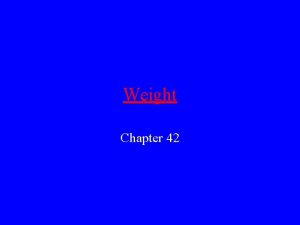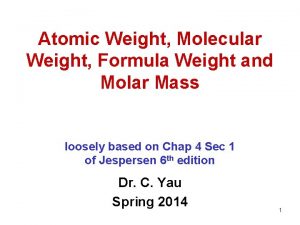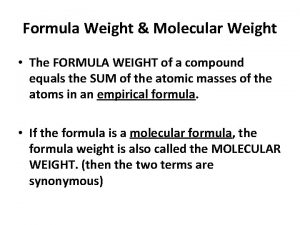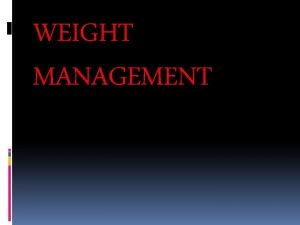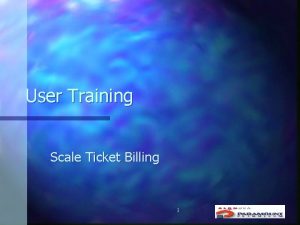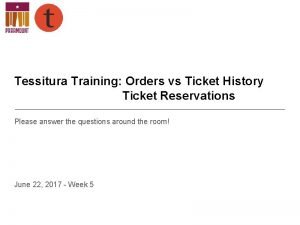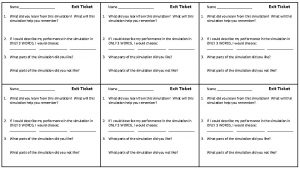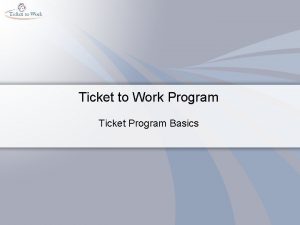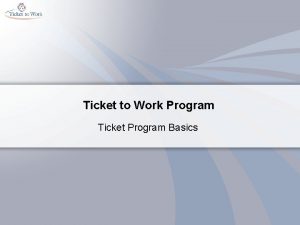Who needs a scale ticket anyway Dealer Weight





































- Slides: 37

Who needs a scale ticket anyway? Dealer Weight and Price Transfer Employee Training Module

Course Objectives Learn + Practice = Successfully complete a dealer weight and price module! Learn: • the importance of using actual weights • the applicable sections of the Act/regulations • weighing and livestock marketing terminology • landmark P&S cases involving weight fraud Practice: • calculating slides and shrink • completing the module • selecting dealers to investigate • opening interview and exit conference

Why is actual weight transfer important? UNFAIR AND DECEPTIVE PRACTICE • Transit shrink makes weight manipulation difficult to detect. • Undisclosed profit can greatly increase cost of cattle. COMPETITIVE COST ADVANTAGE • Livestock can be purchased at a higher price per cwt. than competing buyers can pay. • Livestock can be offered for sale at prices per cwt. below what competitors can offer.

Applicable Sections of the Act & Regs • Section 312 – Unfair and deceptive practices • Regulation 201. 55 – Actual weights • Regulation 201. 49 – Scale ticket requirements • Regulation 201. 73 – Weighers to be competent • Section 403 – Employers responsible for acts of employees • Section 401 – Adequate records

P&S Cases involving weight fraud • P&S Docket 00 -08, W. W. Livestock, Inc. – False and inflated weight Increases • P& S Docket 5753, George W. Saylor Arbitrary weight increases • P & S Docket 5582, Sidney D. Collier and Louis Paul Marsh, Gallop Cattle Co. – Failure to pass shrink allowance

Arbitrary Weight Increase – Unfair! Deceptive! • An arbitrary increase in the purchase weight, whether by adding to the actual weight or by failure to pass on a shrink to a customer, is an unfair and deceptive practice.

Purchase Weight = Sales Weight • In market agency transactions based on purchase weight, the purchase weight is the weight on which the buyer makes payment. • The person receiving the livestock is entitled to expect the weight billed to be the purchase weight, including the full benefit of any shrink allowance.

Shrink Allowance • If any adjustment is made to the actual weight, there must be a prior agreement between the parties with a full and accurate explanation shown on the accounting issued. Records must be maintained to support the weight adjustment.

Willfulness • Weight Manipulation is a fraudulent and willful practice. • Willful violations do not require a NOV (Notice of Violation) to initiate formal administrative action. • Fully document all questionable transactions.

Weight transfer follows two paths: SORTED • Cattle purchased from several sources, moved to a sorting facility, penned by weight range and type and assembled into loads. • Load make-up records used to trace cattle from purchase weight to sale. • Pro-rated shrink is used to divide pens when cattle have lost their identity. DIRECT • Cattle sorted before weighing. • The purchase weight scale ticket supports both the purchase and the sale. • Invoices often include a pencil shrink adjustment. • Trucking records can be important.

Sorted Path: farm/ranch to auction markets for sale to dealers/order buyers.

Dealers/Order buyers move the cattle to sorting pens and sort them into loads.

The dealer’s customer will be a pasture/background operation or feedlot. • The lighter weight cattle (300 -700#) move to a pasture or back-grounding operations where they are grown and started on feed. • Heavier cattle (over 700#) often move directly to feedlots. The buyer of the livestock may be a custom feeding customer.

Direct transactions move cattle from farm/ranch straight to customer. Direct transactions include pasture sales, video sales and online auction sales. The seller and the buyer or buyer’s agent agree to terms that include price, weighing conditions and payment terms.

Again, the dealer’s customer may be a pasture/background operation or feedlot.

What are Some Common Terms? • • • Weighed in the air or on the ground Cuts or Cutbacks Shrink Pencil Shrink allowance Pro-Rated Shrink Base Price Slide Buyer Numbers Pay Weight

“On Ground” or “In Air” Defines How Cattle Will be Weighed • Weighed on the Ground – the cattle will be weighed on a typical livestock scale. • Weighed in the Air – the cattle will be weighed on a truck or trailer utilizing a vehicle scale. The truck/trailer will be weighed empty (tare) and loaded (gross). • Gross Weight – Tare Weight = Cattle Weight

Cuts or Cutbacks • Cattle that do not meet the criteria or specifications for an order. • The criteria used to select the cuts or cutbacks can include weight, breed, sex, color, conformation, horns, condition, illness or injury. • Contracts usually contain language that specifies a percentage of cuts that will be allowed. • Example: Maximum 10% cuts as selected by buyer. • The cuts are usually renegotiated and sold separately.

Shrink • Weight loss that occurs when livestock are handled or shipped. • Shrink starts on the farm or ranch, and continues during sorting, loading and shipping.

Pencil Shrink • Pencil shrink is used to reduce the actual weight to allow for weight livestock will lose in shipment. • Example: A buyer negotiates the purchase of 100 head of 400 weight cattle @ $90. 00 per cwt. less 2% pencil shrink. • 40, 000 lbs. actual weight 800 lbs. 2% pencil shrink 39, 200 lbs. Pay Weight

Shrink Allowance • The maximum amount of shrink that the buyer will accept when cattle are delivered. (arrival weight) • When buyers detect a high transit shrink on a load of cattle, they will often deduct weight and make payment based on a maximum shrink allowance. • Example: 50, 000 lbs. Load with 7% shrink allowance 46, 500 lbs. = Arrival weight @ Maximum shrink allowance 46, 000 lbs. = Arrival weight where pay weight would be reduced by approximately 500 lbs.

Pro-Rated Shrink • A calculation used to proportionately apply shrink to pens of cattle that have lost their individual identity. • The calculation applies the shrink proportionately to the separated lots.

Rules: Pro-Rating Shrink • Every animal in the pen must be weighed. • Divide the total sorted weight into the total purchase weight. • The factor must be greater than 1. 0 and must be carried to at least five decimal places in order to return the cattle to their purchase weight. • Multiply the factor by the weight of each sorted group to obtain the proportionate purchase weight. • The total pro-rated weight must equal the total purchase weight. If not, check for math error.

Regulation 201. 55(a) …Any adjustment to the actual weights shall be fully and accurately explained on the accountings, bill, or statements issued and records shall be maintained to support such adjustment.

Base Price & Weight • Base Price is the initial price of the cattle before any premiums or deductions are applied to determine final price. • Base Price can be reported in cents per pound, dollars per hundred weight (cwt) or price per head. • Base Weight estimates the expected average weight of cattle on the delivery date.

Slide • A price adjustment that is based on the average weight of the load. • The starting point for a slide can be based on deviation from a specific base weight or acceptable base weight range. • Deviations from the base weight usually reduce, but sometimes add to the final price of the livestock. • The contract usually gives the buyer the option to void the contract if the cattle weigh significantly under or over the base weight.

Slide Calculations • 100 steers @ 700 -725 lbs average with $. 04 slide for over and under average • Average weight is 685 pounds = 15 x $. 04 = $. 60 will be deducted from base price. Base Price = $90. 00 -. 60 = $89. 40/cwt • Average weight is 750 lbs. = 25 x. 04 = $1. 00. Base price = $90. 00 – 1. 00 = $89. 00/cwt

Buyer Numbers • Buyer numbers are used by the buyer to separate different types of cattle. • Every dealer develops a system to fit his/her customer needs. • A number often indicates a weight range. • A letter often indicates a sex or other characteristic. • Ask open-ended questions to determine each dealer’s number/letter system.

Pay Weight • Pay weight refers to the weight upon which payment will be based. • The pay weight may be actual or calculated. • Calculated pay weights require disclosure.

Identify Dealer to Review Indicators of Possible Weight Manipulation: • Annual Report reveals a high gross profit per head compared to other dealers. • Complaints from the industry about excess shrink. • No load make-up records available to support weights on sales invoices. • Original sale weights supported by scale tickets represented as being re-weighed weights. • Cattle sold on re-weighed weights with consistent weight gain.

Weight & Price Transfer Regulatory Activity Steps • • • Identify the entity/dealer to investigate. Complete background sheet. Make appointment and request records. Conduct opening interview. Review records and complete WP module. Fully document any weight increases. May need to interview principals to verify. • Conduct exit meeting or exit conference.

Weight Transfer Opening Interview • Ask open-ended questions. Who? What? When? Where? How? and sometimes Why? • Describe your livestock business to me. • Who are the customers? • What are the agreements with the customers? • When and where are weights on sales invoices obtained? • How is shrink adjusted when pens are split? • Listen closely to the answers and ask follow-up questions to clarify the responses.

Records to Review • • Purchase contracts Purchase and sales invoices Bank statements, checks, deposits, wires Load make-up sheets Scale tickets Pen sheets Freight invoices

WP-2 Weight and Price Transactions

WP-2 Weight and Price Transactions

WP-2 Weight and Price Transactions

WP-2 Weight and Price Transactions
 Weight scale ticket
Weight scale ticket Tolerable weight is a body weight
Tolerable weight is a body weight In a bulk-gaining industry
In a bulk-gaining industry Need analysis definition
Need analysis definition Primary needs and secondary needs
Primary needs and secondary needs Henry murray theory
Henry murray theory Strategic gender needs and practical gender needs
Strategic gender needs and practical gender needs Primary needs and secondary needs
Primary needs and secondary needs Whose water is it anyway
Whose water is it anyway Definition of indian constitution
Definition of indian constitution Whos line is it anyway
Whos line is it anyway Sustainable living meaning
Sustainable living meaning Whos taylor swift anyway
Whos taylor swift anyway What is a civilization anyway
What is a civilization anyway What is intelligence anyway by isaac asimov
What is intelligence anyway by isaac asimov So what are you anyway by lawrence hill
So what are you anyway by lawrence hill Whose life is it anyway summary
Whose life is it anyway summary Cattle dealer
Cattle dealer Constant growth dividend discount model
Constant growth dividend discount model Dealer market
Dealer market Car dealer magazine
Car dealer magazine Ucfin dealer
Ucfin dealer Derelict vehicle certificate
Derelict vehicle certificate Division of motorist services
Division of motorist services For dealer use only
For dealer use only Zaz gps reviews
Zaz gps reviews Dealer den kioti
Dealer den kioti Aplikasi dealer motor
Aplikasi dealer motor Galaxy control systems dealer
Galaxy control systems dealer For dealer use only
For dealer use only Vha portal
Vha portal Chatbot development for auto dealer app
Chatbot development for auto dealer app For dealer use only
For dealer use only Pitbull real name
Pitbull real name Auto dealership compliance training
Auto dealership compliance training Svcfin com payment
Svcfin com payment Forest river dealer central
Forest river dealer central Compass@dealer / m4t
Compass@dealer / m4t
